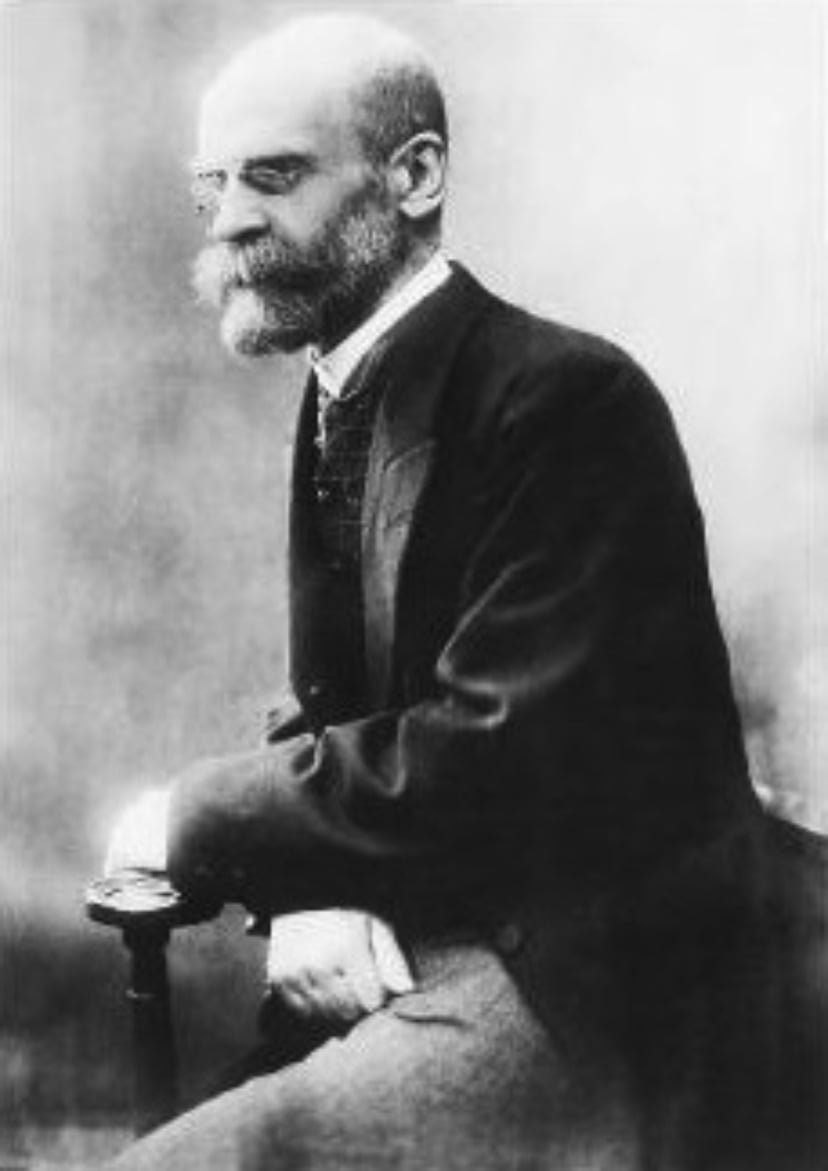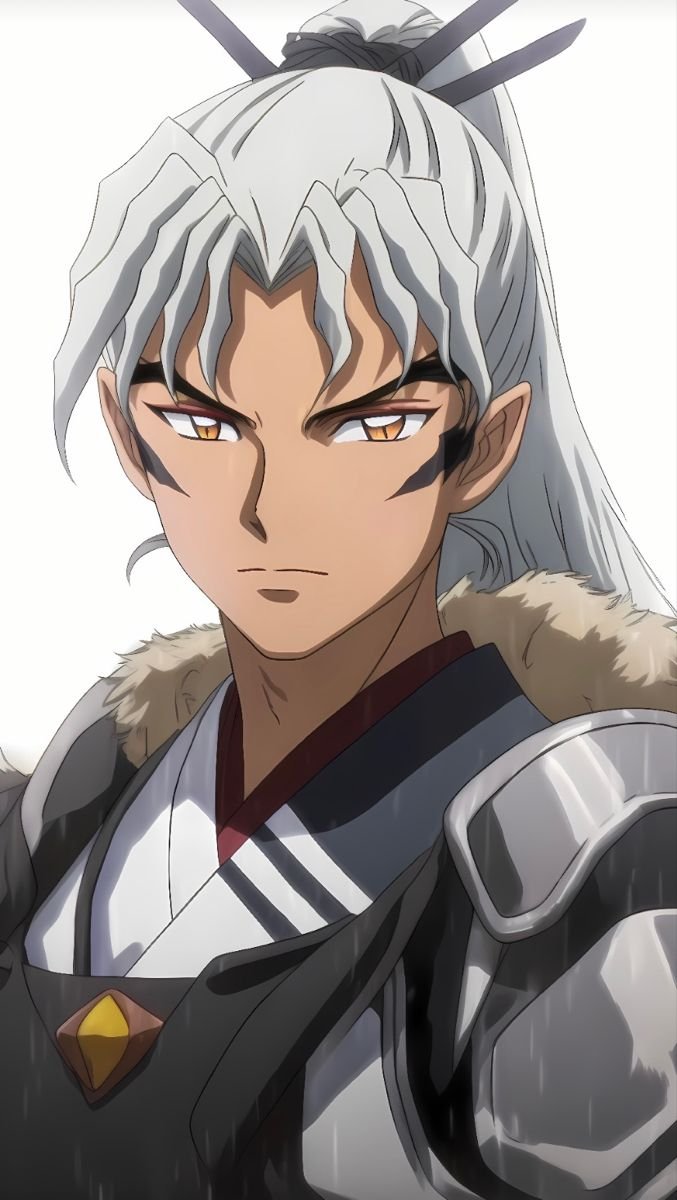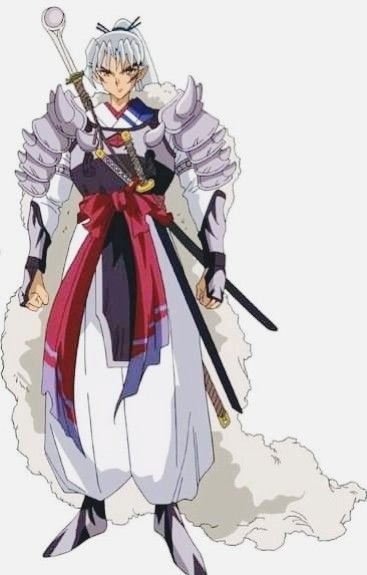

Tōga

|
殺生丸
|
|
|---|---|
| Personal Description | |
| Nihongo | 殺生丸 |
| Name meaning | Fighting Fang |
| Biographical information | |
| Age | 30-40 (physical appearance) |
| Status | Deceased |
| Occupation | Lord of the Western Lands |
| Physical information | |
| Species | Dog daiyōkai |
| Gender | Male |
| Height | 195 cm (6’5″) |
| Eye color | Gold (normal form) |
| Hair color | White |
| Skin color | Tan |
| Physical information | |
| Abilities | Shapeshifting Cold immunity[2] Ability absorbing (via Tessaiga) Resurrection (via Tenseiga) Control over the dead (via Sō’unga) |
| Weapons | Tenseiga |
| Debut | |
| Manga Debut | Chapter 12 |
| InuYasha Anime | Episode 5 |
Tōga
Japanese Name:闘牙 (Tōga)
Meaning of Name:“Fighting Fang”
Titles:Inu no Taishō (Great Dog General), Inu no Daiyōkai (Great Dog-Demon)
Role:Renowned warrior inInuYasha
Species:Inu Daiyōkai (Great Dog Demon)
Family:Father of Sesshōmaru (firstborn) and Inuyasha
Wives:First wife (an inu daiyōkai and Sesshōmaru’s mother); second wife, Izayoi (a human woman and Inuyasha’s mother)
|
Émile Durkheim
|
|
|---|---|
| Born |
David Émile Durkheim
15 April 1858 Épinal, France
|
| Died | 15 November 1917(aged 59)
Paris,France
|
| Nationality | French |
| Alma mater | École Normale Supérieure |
| Known for | Sacred–profane dichotomy Collective consciousness Social fact Social integration Anomie Collective effervescence |
| Scientific career | |
| Fields | Philosophy, sociology, education, anthropology, religious studies |
| Institutions | University of Paris, University of Bordeaux |
| Influences | Immanuel Kant, René Descartes,Plato, Herbert Spencer,Aristotle, Montesquieu, Jean-Jacques Rousseau, Auguste Comte. William James, John Dewey, Fustel de Coulanges, Jean-Marie Guyau, Charles Bernard Renouvier, John Stuart Mill |
| Influenced | Marcel Mauss,Claude Lévi-Strauss, Talcott Parsons, Maurice Halbwachs, Jonathan Haidt, Lucien Lévy-Bruhl,Bronisław Malinowski, Fernand Braudel, Pierre Bourdieu, Charles Taylor, Henri Bergson, Emmanuel Levinas, Steven Lukes, Alfred Radcliffe-Brown, E. E. Evans-Pritchard, Mary Douglas, Paul Fauconnet, Robert N. Bellah, Ziya Gökalp, David Bloor, Randall Collins, Neil Smelser[1] |
Appearance
Tōga is depicted as a towering, regal figure with a strong, muscular build that reflects his power and legendary status. He has long, silver hair that cascades down his back, adorned with armor and a fur pelt that signifies his status as a mighty daiyōkai. Tōga’s aura is commanding, with a presence that invokes fear and respect from both demons and humans alike.

Tōga, the great dog demon and father of Inuyasha and Sesshōmaru, stands tall and regal, exuding an aura of immense strength and nobility, his presence a reminder of the legendary power and legacy he passed down to his sons.
Personality
Known for his honor, courage, and compassion, Tōga was a wise and benevolent ruler who balanced his strength with a sense of justice. Although his power was feared throughout feudal Japan, he showed compassion toward weaker beings and valued the bonds between individuals. His complex and balanced nature allowed him to appreciate life beyond mere strength and conquest. Unlike many daiyōkai, Tōga did not see his humanity as a weakness, and he accepted his relationship with Izayoi, a human woman, and the resulting birth of Inuyasha, with pride and love. His legacy as both a warrior and father is deeply impactful, influencing his sons’ journeys.
Background and Story
Tōga was one of the strongest inu daiyōkai of his time, gaining notoriety across Japan for his unrivaled power and wisdom. He fathered two sons, Sesshōmaru and Inuyasha, by two different wives. His first wife, an inu daiyōkai, bore Sesshōmaru, who inherited Tōga’s pride, strength, and pursuit of power. However, Tōga’s relationship with her eventually fell apart due to differing values. Later, he fell in love with Izayoi, a human woman, and their union produced Inuyasha, a half-demon. Despite the potential for scorn due to Inuyasha’s mixed heritage, Tōga embraced his younger son’s unique nature, intending to pass on his values and legacy.
Tōga met his end while defending Izayoi and their newborn son, Inuyasha, from an attack by Takemaru, a human samurai who disapproved of their union. Tōga fought valiantly to protect Izayoi and, in his final moments, gave her a special robe to shield her from harm, ensuring she would survive to raise Inuyasha. Though he ultimately perished in the battle, his final act solidified his love and dedication to both his family and honor.
Key Rivalries and Relationships
Sesshōmaru
Tōga’s relationship with Sesshōmaru was one of high expectations and lessons. Sesshōmaru admired his father’s strength but struggled with Tōga’s softer side, leading him to pursue his own path of power. However, as he matures, Sesshōmaru realizes the wisdom behind his father’s values.
Izayoi
Tōga’s love for Izayoi defied societal norms, marking him as a daiyōkai who valued personal bonds over societal expectations. His final act to protect Izayoi and Inuyasha demonstrates his unwavering love and commitment, leaving a lasting impact on Inuyasha’s own values.
Inuyasha
Tōga’s relationship with Inuyasha is defined by sacrifice and love. Despite Inuyasha’s mixed heritage, Tōga left him with the Tessaiga, a sword symbolizing protection, to help him navigate the dangers of the world as a half-demon. Tōga’s love and sacrifice for Izayoi and Inuyasha inspire Inuyasha’s sense of justice and strength.
Takemaru
Tōga’s nemesis, Takemaru, represented the prejudice and hostility Tōga faced for choosing to love a human. Their final battle symbolized Tōga’s commitment to defending his family at all costs, even at the expense of his life.
Abilities and Skills
Weapons and Abilities:
Sesshōmaru wields multiple swords, each carrying distinct abilities. His primary weapon is theTenseiga, a healing sword that can revive the dead and protect him from fatal injuries. Although he initially feels disappointed with Tenseiga, he gradually learns to appreciate its power, using it to save Rin and others close to him. He later acquiresBakusaiga, a sword capable of destroying any demonic flesh it cuts, further amplifying his strength.
Sesshōmaru is highly skilled in combat, possessing superhuman strength, agility, and endurance. Hispoison clawsand ability to summon a devastatingwhip of lightmake him a formidable opponent. As an inu daiyōkai, he can transform into a massive, fearsome dog demon, though he rarely uses this form.
Character Development
- Tessaiga:A sword forged from Tōga’s fang, it was left to Inuyasha to protect humans. It embodies Tōga’s belief in compassion as a core aspect of true strength.
- Tenseiga:Another fang-forged sword, Tenseiga was entrusted to Sesshōmaru to represent the duality of strength and mercy. Its healing power gradually teaches Sesshōmaru the value of compassion.
- Sō’unga:A cursed sword with destructive power, which Tōga once wielded and later sealed away. It serves as a reminder of Tōga’s strength and restraint, as he chose to distance himself from its uncontrollable nature.
Trivia
Trivia:
★ Tōga’s character is highly revered, and although he appears only in flashbacks, his influence is deeply felt across the series.
★ His choice to wield multiple swords, each with unique symbolic powers, reflects his complex nature and mastery over both life and death.
★ Tōga’s compassionate side is mirrored in his sons, showing that the true measure of strength includes mercy and protection.